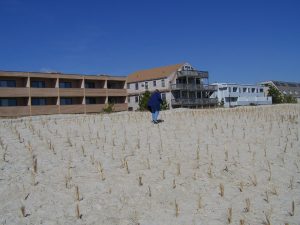 DOVER – Almost one thousand hardy volunteers who turned out in the face of cold and snow for DNREC’s 27th Annual Beach Grass Planting March 19 enabled the planting this year of more than five miles of Delaware shoreline with Cape American beachgrass that helps protect and preserve the state’s dune system, the Division of Watershed Stewardship announced today.
DOVER – Almost one thousand hardy volunteers who turned out in the face of cold and snow for DNREC’s 27th Annual Beach Grass Planting March 19 enabled the planting this year of more than five miles of Delaware shoreline with Cape American beachgrass that helps protect and preserve the state’s dune system, the Division of Watershed Stewardship announced today.
American Cape beachgrass planting at a DNREC Annual Beach Grass Planting event on the Delaware coast“We had close to 1,000 volunteers who braved the cold northeast winds and came out to help,” said event coordinator Jennifer Luoma, DNREC Shoreline & Waterway Management Section. “An amazing turnout given the elements, and a great measure of the volunteer spirit – all to help preserve and make our shoreline more resilient for what the state faces with extreme weather events.”
She noted that volunteers planted in South Bethany, Bethany Beach, Delaware Seashore State Park, Dewey Beach, Rehoboth Beach, Cape Henlopen, Slaughter Beach and Bowers Beach – and “some residents in North Fenwick also planted on State Park land in front of their homes.”
A great percentage of the 150,000 2-stem Cape American beachgrass plugs available for volunteers this year were planted Saturday. The work continued with the better weather this week – “Since Saturday,” Ms. Luoma said, “a probation violator work crew, conservation technicians with the Shoreline and Waterway Management Section and the AmeriCorps NCCC Falcon 5 team all have been planting the remaining grass in South Bethany.”
Their efforts along with volunteers’ perseverance March 19 has brought the total grass planted since the inception of the beach grass event in 1990 to almost 5.2 million stems of Cape American beachgrass planted and helping to stabilize Delaware’s sand dunes along both the state’s ocean and bay beaches.
“The beach grass planting is among the state’s premier volunteer efforts – through good weather and bad, year after year, these dedicated volunteers turn out to put Delaware in a better place for adaptation and resiliency against sea level rise,” said DNREC Secretary David Small. “It’s an event of greater importance than getting plugs of beach grass in the ground to grace our beaches and dunes – and we’re thankful for the volunteers who acknowledge that importance in turning out for DNREC’s annual beach planting.”
Beach grass helps to build and stabilize dunes by trapping windblown sand. As the grass traps sand, it helps build the dunes higher and wider, which makes a dune more protective of the structures behind it. The Shoreline & Waterway Management Section also advises that beach grass has thick brittle stalks that can be easily broken and killed by pedestrian or vehicular traffic. The section also notes that recently-planted grasses, as went into the dunes during this year’s DNREC beach grass planting event, are very vulnerable to pedestrian traffic until dune fencing is installed.
Beach grass planting coordinator Ms. Luoma also expressed gratitude for sponsorship from Pepsi Co and Giant Foods in Ocean View for supplying beverages to volunteers; the Delaware Mobile Surf-Fishermen, Inc. for providing transportation on the beach along with refreshments; the Towns of Dewey Beach and Bowers Beach for providing restrooms, and Delaware State Parks for waiving fees for volunteers participating in the event.
Media Contact: Melanie Rapp, DNREC Public Affairs, 302-739-9902
Vol. 46, No. 97
